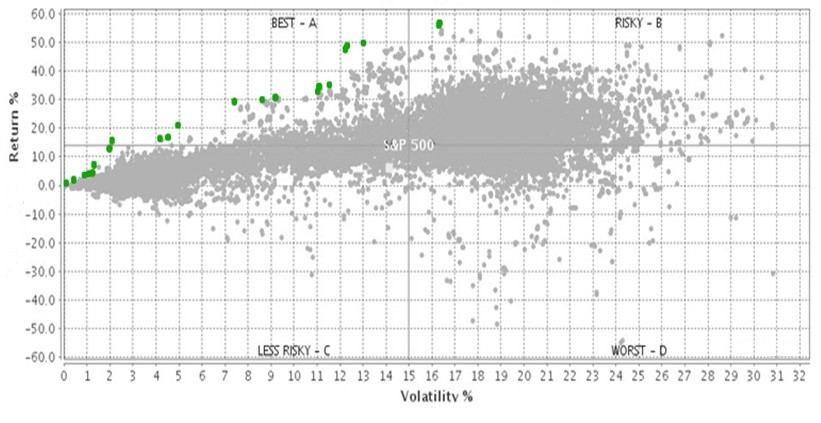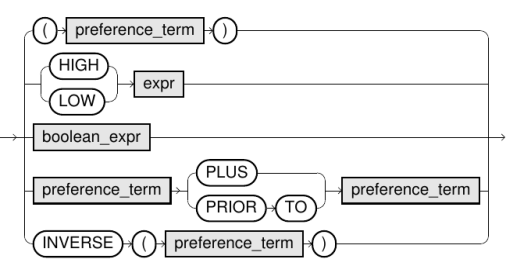This article describes the Skyline SQL extension.
Skyline is an SQL extension for data analysis developed by Exasol. It solves the following problems with large data volumes with multi-criteria optimization:
- Data flooding
- Very large data volumes can be almost impossible to analyze. When navigating through millions of data rows, you typically sort by one dimension and regard the top n results. Because of that, you will almost never find the optimum result.
- Empty result
- You often use filters to simplify the problem of large data volumes. Most of the time they are too restrictive and lead to empty result sets. By iteratively adjusting the filters, people try to extract a controllable data set. This procedure prevents finding the optimum result.
- The difficulty of correlating many dimensions
- When many dimensions are relevant it can be impossible to find an optimum result using plain SQL. By the use of metrics, analysts try to find an adequate heuristic to weight the different attributes. By simplifying the problem to only a single number, a lot of information and correlation within the data is then lost. This strategy will seldom produce the optimum result.
How Skyline works
Instead of using hard filters through the WHERE clause and metrics between columns, the relevant dimensions are specified in the PREFERRING clause. Skyline uses this to provide the optimal set. The optimal set, also known as the Pareto set, which is the number of non-dominated points in the search space. By definition, a point is dominated by another one if it is inferior or equal in all dimensions, and it must be inferior in at least one dimension.
Let’s take a scenario of optimized space with just two dimensions. You have to decide on a car by using two attributes: high power and low price. A car A is dominated by car B if its price is lower or equal, and its performance is higher or equal than A, but they are not equal in both dimensions. It will be challenging to decide if only one dimension is superior and the other dimension is inferior. In this case, the Pareto set will be the set of cars with preferably high performance and low price.
Without Skyline, you can only try to find a reasonable metric by combining the performance and price in a formula, or by limiting the results by a certain price or performance range. However, the optimum result will not be identified by this approach.
With Skyline, you can specify the two dimensions within the PREFERRING clause (PREFERRING HIGH power PLUS LOW price) and get the best result in return. The Skyline algorithm compares all the rows of a table with each other based on the PREFERRING clause. In contrast, you can determine (sorting by number) the result by using a simple metric. However, the complexity of the correlations is totally eliminated. Skyline provides the possibility of considering the structure of the data and finding the optimum result set.
You can use the PREFERRING clause in the SELECT, DELETE, and UPDATE statements.
Example
To illustrate the capabilities of Skyline, let’s consider the selection of the best funds in the market. To select good funds, you can use attributes, such as performance, volatility, an investment fee, ratings, yearly cost, and so on. To simplify the example, we take only the first two attributes: performance and volatility. Performance and volatility have a reversed correlation. The more conservative a fund is, the lower its volatility is, and so is performance.
In the following image, thousands of funds are plotted based on its performance and volatility. The green dots are the results provided by the Skyline query. These funds represent the optimum subset based on the two dimensions. Based on this result, you can decide on the best fund in the market.

SELECT * FROM funds PREFERRING HIGH performance PLUS LOW volatility;Syntax elements
As described in the SELECT statement, you can define the PREFERRING clause after the WHERE condition. It contains the following elements:

preference_term::=

| Element | Description |
|---|---|
|
|
If you specify this option, the preferences are evaluated separately for each partition. |
|
|
Defines whether an expression should have high or low values. Numerical expressions are expected. |
|
Boolean expressions |
In the case of boolean expressions, the elements are preferred where the condition
results in TRUE. The expression |
|
|
By using the keyword |
|
|
With this clause, you can nest two expressions hierarchically. The second term will only be considered if two elements have the same value for the first term. |
|
|
By using the keyword |
The following example shows a more complex scenario to select a car based on the nested expressions:
- The performance is segmented by steps of tens.
- The price is segmented by steps of thousands.
- In the case of identical performance and price, the color silver is preferred.
SELECT * FROM cars
PREFERRING (LOW ROUND(price/1000) PLUS HIGH ROUND(power/10))
PRIOR TO (color = 'silver');